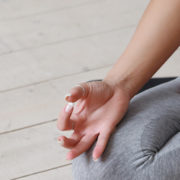This article is from the Train Your Brain course by Rick Hanson, Ph.D. and Richard Mendius, M.D.
What Is Mindful Presence?
©Rick Hanson, PhD and Rick Mendius, MD, 2007
This class is about developing the skill of mindful presence. Let’s unpack those two words, mindful presence. Mindfulness is simply a clear, non-judgmental awareness of your inner and outer worlds. In particular, it’s an awareness of the flow of experience in your inner world – an alert observing of your thoughts, emotions, body sensations, desires, memories, images, personality dynamics, attitudes, etc.
When you are mindful of something, you are observing it, not caught up in it and not identified with it. The psychological term, “the observing ego” – considered to be essential for healthy functioning – refers to this capacity (i.e., mindfulness) to detach from the stream of consciousness and observe it. Other terms for this capacity include bare witnessing and the Fair Witness.
Mindfulness is an everyday psychological capacity, not some kind of lofty mystical state. To quote an unidentified meditation master: “Even children, drunkards, madmen, those who are old, or those who are illiterate, can develop mindfulness.”
Presence refers to the stability of mindfulness, which means the degree to which you are grounded in awareness itself.
With practice, awareness becomes increasingly your home base, your refuge, rather than the contents of awareness. You abide more and more as the field of awareness upon which experiences arise, register, and pass away.
The sense of awareness itself starts taking up more and more space in your daily experience; you certainly still get caught up in and swept along by mental contents many times a day, but you find there is more of a feeling of background awareness even then, plus you return to the awareness position more quickly, and stay there longer.
As mindful presence increases, there is a growing sense of being as the container of your everyday life, which holds the doing and the having of daily activities. You are being being. Doing and having no longer contain little moments of being; instead, being is increasingly the ongoing space through which ripples of doing and having
come and go.
This quality of abiding as awareness moves out into your life beyond time spent meditating. Simply stretching your hand for a cup of coffee or tea becomes increasingly infused with a sense of full awareness of that act. So with other physical activities.
With people, you become more settled into being fully there with them, more peacefully relaxed in awareness of them and you and what’s happening, less identified with pleasant or unpleasant reactions that arise, less caught up in the past or future or sense of needing to make something happen. We can feel it immediately when someone else is mindfully present with us; similarly, others can feel it when you are that way yourself.
What is the Neuropsychology of Mindful Presence?
When you are mindfully present, you are activating the most fundamental, central circuits of the nervous system, namely core consciousness and the parasympathetic nervous system. It is interesting and really nice that the experience of these bedrock circuits is so pleasant and comfortable.
Core consciousness is supported by structures in the brain stem and limbic system; these are ancient, in an evolutionary sense, and are used by animals to survive by registering both external events – food, predators, etc. – and internal states (e.g., pain, thirst) The parasympathetic wing of the autonomic nervous system is responsible for the fundamental maintenance of bodily functions, including breathing, heart beat, digestion, rest, and sleep. Its complement is the sympathetic nervous system, which is responsible for both “go-get-it” responses to opportunities and “fight or flight” responses to stress. Even though that sympathetic wing gets a lot of attention in our go-go, consumer pleasure, aggressive, action movie, videogame culture, the parasympathetic system is more central: you can live without your sympathetic nervous system, but if your parasympathetic nervous system were deactivated, you would die quickly.
The parasympathetic nervous system was the topic of the first class in the Train Your Brain series, and for more information, go to the Wise Brain website and download the talk and article from that class.
Why Develop Mindful Presence?
Mindful presence feels good in its own right: relaxed, alert, and peaceful. Not contending with anything. No struggle.
In addition to the inherent, experiential rewards of mindful presence, studies have shown that it lowers stress, makes discomfort and pain more bearable, reduces depression, and increases self-knowledge and self-acceptance.
To quote the father of American psychology, William James:
“The faculty of voluntarily bringing back a wandering attention, over and over again, is the very root of judgment, character, and will. No one is compos sui [master of himself] if he have it not. An education which should improve this faculty would be the education par excellence. But it is easier to define this ideal than to give practical directions for bringing it about.” – William James, Psychology: Briefer Course, p. 424 (Harper Torchbooks, 1961)
(By the way, the major quotes given in this article are gathered together at the end of it, below.)
At a deeper level, mindful presence is the counter to our habitual state of mind, which a Thai meditation master once summarized as, “Lost in thought.”
To quote Jack Kornfield:
“ . . . you [become] mindful of the constantly changing conditions of sight, sound, taste, smell, physical perceptions, feelings, and thoughts.
Through mindfulness practice, you [begin] to experience how conditioned the world is and how these conditions constantly change. To free ourselves, we need to quiet the mind through some mindfulness in meditation. Then, instead of identifying with the changing conditions, we learn to release them and turn toward consciousness itself, to rest in the knowing. Ajahn Chah called this pure awareness, “the original mind,” and resting in “the one who knows.”
The senses and the world are always changing conditions, but that which knows is unconditioned. With practice . . . we can be in the midst of an experience, being upset or angry or caught by some problem, and then step back from it and rest in pure awareness. . . We learn to trust pure awareness itself.” – Jack Kornfield, Buddhadharma, Summer 2007, pp. 34-35
And in addition to the psychological, everyday benefits of mindful presence, it is also, in Buddhism, considered to be a direct path to enlightenment and the end of suffering:
“This is the one-way path for the purification of beings, for the surmounting of sorrow and lamentations, for the passing away of pain and dejection, for the attainment of the true way, for the realization of Nibbana – namely, the four establishments of mindfulness.
“What are the four? A person dwells contemplating the body in the body, ardent, clearly comprehending, and mindful, having subdued longing and dejection in regard to the world. He or she dwells contemplating feelings in feelings, ardent, clearly comprehending, mindful, having subdued longing and dejection in regard to the world. He or she dwells contemplating mind in mind, ardent, clearly comprehending, mindful, having subdued longing and dejection in regard to the world. He or she dwells contemplating phenomena in phenomena, ardent, clearly comprehending, mindful, having subdued longing and dejection in regard to the world.” [In the Buddha’s Words., p. 281]
This isn’t the place to get into detail about that quote, though I invite you to let the feeling of it carry you along. And for more information, you can go the article on our website about the Eightfold Path and read the section on Right Mindfulness.
But in passing, it is worth noting that “contemplating body in the body” (or feelings in feelings, mind in mind, phenomena in phenomena) means being simply aware of immediate, experiential phenomena as they are without conceptualization or commentary. Just the sensations of the rising breath in the belly. Just the subtle feeling of a sound being mildly unpleasant. Just the sense of consciousness being contracted or spacious. Just a single thought emerging and then disappearing. Just this moment. Just this.
There’s a pithy summary of this simplicity of pure experiencing in the advice the Buddha gave to a man named Bahiya:
“Bahiya, you should train yourself in this way: With the seen, there will be just the seen; with the heard, there will be just the heard; with the sensed (touched, tasted, smelt) there will be just the sensed; with the cognized [thoughts, feelings, etc.], there will be just the cognized.”
In sum, imagine being in a lovely and peaceful meadow, with a train full of thoughts and feelings and desires rolling by in the distance . . . Normally, as this train approaches we tend to become drawn in, and we hop on board and get carried away . . . “lost in thought.”
On the other hand, mindfulness allows you to see the train coming but have the presence of mind . . . to stay in the meadow! And whenever you get swept along by the train, as soon as you notice that, whoosh, you return immediately to the peaceful meadow, to the refuge of mindfulness.

Concentration Tune Up
Steady mindfulness requires overcoming the natural – and evolutionarily adaptive – tendency of mind to scan endlessly and think of new things. So the basic capacity to steady the mind – called concentration, as a short-hand – is a condition for mindfulness.
We covered concentration in the last TYB class, so check out the talk from that class on the Wise Brain website – and the “Factors of Concentration” at the end of this article, below. You could also look at the Right Concentration section of the Eightfold Path article on the website.
Right here, if you like, you can do a little tune-up of concentration skills as a foundation for the mindful presence exercises we will be presenting further on.
Instructions
You could take 10 minutes or so to just concentrate on one thing. You can pick whatever object you like, but we’ll will give instructions in terms of the sensations of the breath felt around the upper lip. If those are too subtle, you could also use the sensations in the belly.
For concentration, it’s generally best to pick a single, focused object of attention – such as the sensations of the breath in one area, rather than the feeling of breathing overall – and stick with that object rather than moving from object to object.
So let’s get started:
- Sit in a relaxed yet comfortable position.
- Eyes open or closed, whatever works for you. Eyes closed often helps people focus on the breath.
- If you feel sleepy you could open your eyes or stand up.
- Try to be aware of the sensations of each breath – inhalation and exhalation – from beginning to end.
- It’s OK to have your mind wander some. Just return your attention to the breath. Be kind to yourself as you do so.
- If you like, you could count each breath, and start over when you get to 10 or if you lose track.
- Try to be with each breath as a fresh, unique breath, an individual in its own right.
- Increase your attentiveness if you feel it starting to crumble or wander.
- Keep watching your quality of intention and focus. You are watching the watching to make sure the watcher is doing a good job.
- You’ll be getting increasingly absorbed in the sensations of the breath.
OK, let’s dive in.
[However much time you like . . . . . . ]
OK, how was that for you? What helped you stabilize attention, steady your mind?
Basic Mindfulness
Next, we are going to shift to a standard form of mindfulness meditation, in which you keep maybe a third of your attention on your breath (or something else) that helps stabilize and anchor your attention. With the rest of your attention, you are simply aware of whatever else streams through awareness.
Remembering the metaphor of the meadow, you are not getting caught up in the “trains” of mental contents, but simply watching them go by. You may find it helpful to softly note some of those contents, including more global states of mind, such as “thinking,” “worry,” “itching,” “pressure,” “coughing,” “peacefulness,” “quiet,” “restlessness,” “doubt,” “self,” etc.
If your mind wanders, just bring it back to the breath. If it is wandering a lot, maybe take a minute to reestablish concentration on the breath – so it is your only focus for that minute – and then resume the standard mindfulness meditation.
You may find your mind growing very quiet or peaceful or happy. Then those states of mind are what is present in awareness, and you can be mindful of that. It is alright to have a gentle quality of investigation, of curiosity, but this is not the time to psychoanalyze yourself – you can get caught up in investigation just like any other mental content.
It’s also alright to register insights into yourself individually or into the general nature of mind or existence. You can take a moment to digest the insight so it becomes a part of you and available for reflection later, and then return to the formal mindfulness meditation.
Instructions
So let’s begin. Find a comfortable posture. Find that stable anchor with the breath. Take a few breaths and be aware of their sensations. OK, let’s dive in.
[However much time you like . . .]
OK, how was that for you? Could you get a sense of spacious awareness, through which the contents of the “stream of consciousness” flowed?
Open Space Mindfulness
Now we are going to distill that mindfulness meditation down to its very essence: abiding as awareness primarily, with little involvement with or even sense of the contents of awareness, almost indifferent to them. The focus is on the open space of awareness itself – which is the name often used in Tibetan Buddhism for this sort of meditation.
By the way, profound forms of this meditation go very very far, and are sometimes associated with the viewpoint that the primordial essence of awareness is “Buddhanature,” “stainless and pure and unconditioned,” and perhaps even mysteriously Transcendental.
We are not aiming so high, here tonight, and instead pursuing the everyday skill of being aware of awareness itself, and being able at will to rest – for at least seconds at a time – in such a way that awareness is the bulk of what one is experiencing, rather than its contents.
You’ll note I spoke of seconds at a time. A few seconds spent abiding primarily as awareness are great! In the beginning, it is normal for that sense to “crumble” and for the field of experience to become dominated, as it usually is, by various thoughts and feelings, desires and plans, etc. With practice, the duration of your abiding as awareness will lengthen, but for tonight it’s just fine to go into and out of it.
You’ll also note that I keep using the word “resting.” Abiding as awareness is rooted in a deeply rested feeling – which is of course the epitome of the experience of the parasympathetic nervous system, whose motto is “rest and digest.” (Even more fitting, perhaps, is the motto of the Turtle Club: “Start slow and taper off.”)
In fact, a traditional instruction for open awareness meditation is to imagine how you would feel at the end of a long day of good work, and you come home and just sit down and rest. That sense of abandoning yourself to resting deeply, with a related feeling that it is healthy to do so, is a doorway to abiding as awareness.
Here’s a quote from a Tibetan Buddhist teacher, Yongey Mingyar Rinpoche [Rinpoche is a title, like sensei]:
“If you truly want to discover a lasting sense of peace and contentment, you need to learn to rest your mind. Only by resting the mind can its innate qualities be revealed. The simplest way to clear water obscured by mud and other sediments is to allow the water to grow still. In the same way, if you allow the mind to come to rest, ignorance, attachment, aversion, and all other mental afflictions will gradually settle, and the compassion, clarity, and infinite expanse of your mind’s real nature will be revealed.” The Joy of Living, p. 125
Since you are taking your home in awareness itself, the contents of mind don’t matter much. This includes perceptions such as sights and sounds. That is why people are encouraged, as they become more practiced with this mode of meditation – actually, this mode of being – to do it with their eyes open. Since sight is such a central sense – literally about a third of the cerebral cortex is devoted to visual processing – if you can become relatively disengaged from what you see through being deeply invested in awareness itself, then you’ve come a real way. You can experiment with this yourself during the brief meditations we are about to do, and try them sometimes with eyes open and other times with your eyes closed.
A couple more tips, and then we’ll try it:
- Some people find that it helps to bring to mind the spacious or luminous quality of awareness, though sometimes the effort to sense spaciousness or luminousness simply turns them into more contents of mind, when in fact you want to disengage from contents.
- You may find that when you are resting in awareness, that thoughts and feelings come and go almost out of sight, as it were. That’s fine. To quote Mingyar Rinpoche again: “The real point of meditation is to rest in bare awareness whether anything occurs or not. Whatever comes up for you, just be open and present to it, and let it go. And if nothing occurs, or if thoughts and so on vanish before you can notice them, just rest in that natural clarity. How much simpler could the process of meditation be?” The Joy of Living, p. 131
- Don’t worry if it seems hard at first. Awareness is completely natural: you’re aware right now, right? In open awareness meditation, you’re simply abandoning involvement with everything except awareness itself. Since awareness is your natural home base, your natural resting state, Mother Nature is on your side as you settle more and more into simple awareness.
But keep in mind that resting in awareness is a skill like any other, and therefore takes time to practice. Try not to be frustrated or angry with yourself if this doesn’t come easily for you. If you bump into difficulties, there will still be benefits, since you will be gaining a good deal of insight into the activities of mind that carry you away from simple awareness.
Instructions
Let’s try this for one minute. To repeat, get a sense of resting deeply, not trying to do anything at all, with your body deeply relaxed – especially the trunk of it – and simply have most of who you are in the moment be just awareness. OK, here we go.
[About a minute . . .
OK, how was that? Let’s try it again, this time for three minutes.
OK, here we go.
[About three minutes . . .
OK, how was that? And now let’s try it again for a few minutes, but this time, how about trying it standing up with your eyes open? OK, here we go.
[About three minutes . . .
OK, how was that?
Conclusion
Try to be as mindful as you can in daily life, and see what that’s like. Try to take your sense of mindful presence from exercises like in this article, or from your meditations, and bring that out into the world. Enjoy!
Quotations
. . . you [become] mindful of the constantly changing conditions of sight, sound, taste, smell, physical perceptions, feelings, and thoughts. Through mindfulness practice, you [begin] to experience how conditioned the world is and how these conditions constantly change.
To free ourselves, we need to quiet the mind through some mindfulness in meditation. Then, instead of identifying with the changing conditions, we learn to release them and turn toward consciousness itself, to rest in the knowing. Ajahn Chah called this pure awareness, “the original mind,” and resting in “the one who knows.”
The senses and the world are always changing conditions, but that which knows is unconditioned. With practice . . . we can be in the midst of an experience, being upset or angry or caught by some problem, and then step back from it and rest in pure awareness. . . We learn to trust pure awareness itself.
Jack Kornfield, Buddhadharma, Summer 2007, pp. 34-35
Even children, drunkards, madmen, those who are old, or those who are illiterate, can develop mindfulness.
Unidentified meditation teacher
The faculty of voluntarily bringing back a wandering attention, over and over again, is the very root of judgment, character, and will. No one is compos sui [master of himself] if he have it not. An education which should improve this faculty would be the education par excellence. But it is easier to define this ideal than to give practical directions for bringing it about.
William James, Psychology: Briefer Course, p. 424
If you truly want to discover a lasting sense of peace and contentment, you need to learn to rest your mind. Only by resting the mind can its innate qualities be revealed. The simplest way to clear water obscured by mud and other sediments is to allow the water to grow still. In the same way, if you allow the mind to come to rest, ignorance, attachment, aversion, and all other mental afflictions will gradually settle, and the compassion, clarity, and infinite expanse of your mind’s real nature will be revealed.
Yongey Mingyar Rinpoche, The Joy of Living, p. 125
The real point of meditation is to rest in bare awareness whether anything occurs or not. Whatever comes up for you, just be open and present to it, and let it go. And if nothing occurs, or if thoughts and so on vanish before you can notice them, just rest in that natural clarity. How much simpler could the process of meditation be?
Yongey Mingyar Rinpoche, The Joy of Living, p. 131
Factors of Concentration
“. . . ardent, diligent, resolute, and mindful . . . “
Introduction
These factors support steadiness of mind, particularly applied toward mindfulness in meditation and daily life. Different things work for different people, so see what’s best for you. (The examples used referred to the breath, though other objects of attention could be used.)
Factors
• Have a clear and stable object of attention – Pick a single, specific object of attention – such as the sensations of the breath in one area of the body, rather than the feeling of breathing overall – and generally stick with that object rather than moving from object to object (though occasionally it works to shift to one or two other objects).
• Set your intention – Resolve to keep your mind on its desired object.
• Be kind – Wish yourself well, and try not to be self-critical or too goal-directed.
• Relax – Calm your body, and release any sense of stress or emotional upset.
• Be alert – Perhaps energize your body in advance with some stretching, or choose times for contemplation that support alertness. If you feel drowsy, open your eyes, stand up, or imagine light. “Brighten the mind” with a mild surge of what could feel like adrenaline (it’s actually norepinephrine).
• Feel safe – Bring to mind things that help you feel as safe as possible, such as knowing you are in a protected place, recalling others who love you, etc.
• Routinely regenerate your intention – For example, if you’re focusing on the breath, you could re-commit to staying with the inhalation at the start of each one, and similarly with each exhalation.
• Deliberately apply and sustain attention – These are two of the five traditional factors of concentration.
• Appoint an overseer – Imagine a part of the mind that keeps watching how well your attention stays focused on the object. Regenerate the sense of that overseer if it starts to fade.
• Use verbal cues – Softly, in the background of your mind, you could count each breath, from one to ten, starting over if you get to ten or lose track. Or softly note the sensations of the breath (“in,” “out” or “rising,” “falling”).
• Enrich the stimulus – Orient to each breath as a unique, fresh breath. Explore the details of the sensations of it.
• Adapt your practice to your nature – Some people naturally need more stimulation than others; if that’s true for you, try concentrating while walking very slowly or during other movements.
• Encourage positive emotions – Be mindful of and even intensify positive feelings; bodily bliss and happiness/contentment/tranquility are two other traditional factors of concentration. If these feelings become intense, they could become the new objects of attention.
• Be comfortable with neutral experience – Accept that most experience is neutral, and need not prompt looking for pleasant experiences.
• Receive the object of attention – Rather than going out to the object, let it come into your awareness in an effortless way. Be receptive, rather than active.
• Be devoted to the object – Cultivate a sense of warmth and friendliness toward the object.
• Abandon all other interests – Be uninterested in anything other than the chosen object of attention during the time you’re concentrating; renounce everything else. Remind yourself you’ll have plenty of time later to think about other things.
• Push away distracters – Be aware of distractions arising that might capture your attention, and before they take full form, gently disengage from them, even with a sense of lightly batting them away and returning to the object you’ve chosen.
• Settle into absorption – Encourage a growing unification of awareness with its object, with everything else receding into the background of awareness, falling away.
• Encourage one-pointedness – The last traditional factor, this is a sense of experience being one whole unified percept. It usually arises when absorption deepens, and is also characterized by a growing equanimity and quiet in the mind.
• Trust yourself – There is a natural intelligence in the mind, and you will find your own way to deepening concentration. Explore what works best for you.
Grounded in the belief we are all unique beings, we begin each new client with a meticulous bio-mechanical evaluation, assessing each joint in it’s relationship to the movement of the body as a whole. Our therapists are skilled at reading the unique story your body tells, and treating everything from the bottom of your foot to the top of your head.
Bodywise Physical Therapy is located in Portland, Oregon. The Bodywise approach is wholistic, individualized, and can benefit people of all fitness levels. While Bodywise has always specialized in general orthopedics, spine rehabilitation, and sports medicine, they have evolved into a truly wholistic practice integrating Hands-on treatments with Mindfulness, Pilates, Trauma Release Exercise, Women’s Health and Lymphedema.













